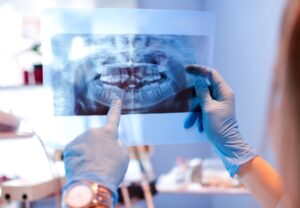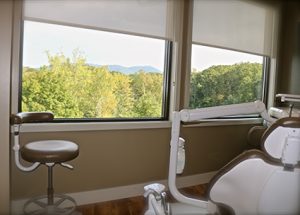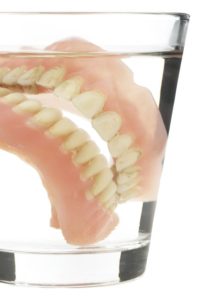Header logo
header top contact widget
Implant Placement
Smoking, Vaping Lead To Gum Disease, Tooth Loss.
Posted on Sep 15, 2020 by William J. Claiborne, DDS MS
With all good intentions, adults occasionally trade one bad habit for another. For instance, a commitment to exercise more often for weight loss can easily backfire when justifying a thick smoothie as a daily reward.
This is what worries me about Vaping. Vaping, the use of e-cigarettes, hit the market around 2007. It is designed to deliver nicotine through a vapor. Although the vapor is generally not labeled as harmful (it’s not “safe”, either), its nicotine is no less harmful to the user as that delivered via cigarette smoke.
Unfortunately, many cigarette users switched to vaping based on the perception that “e-cigs” were a safer alternative. For those who wanted to wean themselves off of cigarettes through this switch, very few achieve that goal as a result.
A 2018 report by the National Academy of Sciences, Engineering, and Medicine concluded there was “evidence that e-cigarette use increases the frequency and intensity of cigarette smoking in the future.”
Teens have been most susceptible to the hazards of vaping. It is the most commonly used tobacco product among U.S. youth. E-cigarette use among middle and high school students increased 900 percent during 2011-2015. According to the Surgeon General, 1 in 5 high school students and 1 in 20 middle school students were using e-cigarettes in 2018.
Unfortunately, nicotine exposure can harm the brain as it develops, until about age 25. During adolescence, nicotine use can affect learning, memory and attention span as well as increase their risk for future drug addictions. (https://e-cigarettes.surgeongeneral.gov/documents/surgeon-generals-advisory-on-e-cigarette-use-among-youth-2018.pdf)
As a periodontist in Asheville, NC, my concern when it comes to oral health is what many cigarette smokers and vapers don’t realize when it comes to high risks to their smiles.
In our periodontal dental office, I’ve seen how significantly the habit of cigarette smoking can have on one’s smile. It’s no secret that smoking cigarettes can stain teeth and cause bad breath. However, nicotine in any form is a hazardous force in the mouth.
According to the American Dental Association (ADA), smoking can cause the gums to recede from teeth, exposing vulnerable tooth root sections. This enables easier entry of oral bacteria into the structures that support tooth roots. Smoking can also delay healing following periodontal therapy, extractions or implant placement. The longer it takes oral tissues to heal, the greater the risks for infection to develop.
Additionally, smoking increases the risks of oral cancer, lesions inside the mouth, periodontal (gum) disease, enamel erosion and tooth loss. It greatly reduces saliva flow in the mouth, which is a tremendous aid in removing bacteria and food particles from the mouth, helping to control bacteria levels. The condition of “dry mouth” also causes bad breath.
Because of the vape’s moist presence in the mouth, the assumption with vaping over smoking cigarettes is the “benefit” of oral dryness. However, this is easily dispelled when looking at the true facts.
While there are more than 7,000 chemicals found in the smoke of tobacco products, (including nicotine, tar, carbon monoxide, acetaldehyde and N-nitrosamines), nicotine is the primary addicting component. A study of some e-cigarette products found the vapor contains known carcinogens and toxic chemicals, as well as potentially toxic metal particles from the device itself.
The e-liquids delivered by these devices typically contain nicotine, propylene or polyethylene glycol, glycerin, and additives. Sound safe? Not at all.
According to the Centers for Disease Control & Prevention (CDC), a smoker has twice the risk for gum disease compared with that of a nonsmoker. (https://www.cdc.gov/tobacco/campaign/tips/diseases/periodontal-gum-disease.html)
When a patient is diagnosed with advanced periodontal disease (periodontitis), they must make a commitment of time and expense to rid this inflammatory disease from their mouths. For those who ignore its presence or assume it will get better on its own, the disease will simply progress further.
Gum disease begins with sore gums that may bleed while brushing teeth. Or, it may cause no noticeable symptoms at all in early stages.
As it worsens, gum disease will cause frequent bad breath, tender gums that turn red, gum recession, and gums that bleed easily when brushing. Pus pockets may form on the gums. As it attacks the structures beneath the gum line, teeth may loosen or shift.
As the nation’s leading cause of adult tooth loss, it brings the hard decisions (and expense) for replacement. After all, you need teeth for eating and speaking. Do you go with dental implants? Or, do you take on the challenges that come with dentures and partials? As hard as the decisions of replacing teeth can be, gum disease can bring even more devastation with it.
Research has linked the bacteria of gum disease to serious health problems. These include heart disease, stroke, preterm babies, arthritis, diabetes, impotency, some cancers and even Alzheimer’s disease. These connections occur through the infectious bacteria of gum disease entering the bloodstream through tears in diseased gum tissues.
Once in the bloodstream, the bacteria can travel throughout the body and create inflammatory reactions. This “systemic inflammation” is able to trigger the onset of some diseases and conditions or even further the development of others.
Certainly, we all have the right to determine what is in our best interest as far as our own health goes. However, I believe that many individuals end up in our office with serious gum problems and facing tooth loss because of what they did not know. Having factual information allows us to make wise decisions for our health and well-being.
As a periodontist, I have advanced skills in the treatment of all stages of periodontal (gum) disease. My dental specialty also includes the diagnosis and placement of dental implants. Here, our patients can relax under Oral or IV sedation (“twilight sleep”) while having their smiles restored. We also create a customized care program that allows each person to maintain good oral health once their treatment is complete.
 If you smoke or vape, don’t assume “that won’t happen to me.” The reason we wear seat belts in cars is because there are great risks when we do not. The risks for losing your teeth and having potent bacteria running rampant through your system is something you can take easy measures to prevent.
If you smoke or vape, don’t assume “that won’t happen to me.” The reason we wear seat belts in cars is because there are great risks when we do not. The risks for losing your teeth and having potent bacteria running rampant through your system is something you can take easy measures to prevent.
Experiencing symptoms associated with gum disease? We urge you to schedule an examination appointment as soon as possible. Call our beautiful, comfortable Asheville office at 828-274-9440. A referral is not necessary.
How To Avoid Thinning Jaw Bones That Cause “Granny Look”
Posted on Sep 10, 2020 by William J. Claiborne, DDS MS
Imagine your mouth begins to sink into your face. Deep wrinkles form around your mouth and the corners of the mouth begin to turn downward, even when you smile. Jow ls form, allowing skin to seem to loosen and hang on both sides of the face. The chin becomes more pointed and the nose and chin get closer and closer.
ls form, allowing skin to seem to loosen and hang on both sides of the face. The chin becomes more pointed and the nose and chin get closer and closer.
This sounds pretty awful. It is like a disfigurement of the face. It’s not a horror movie, though. This is real, caused by one of the most preventable of all diseases afflicting American adults. It’s a disease that affects over 47 percent of all adults over the age of 30. For adults over the age of 65, the figure rises to over 70 percent. (https://www.cdc.gov/oralhealth/conditions/periodontal-disease.html)
Amazingly, this highly prevalent disease is simply periodontal disease. Often referred to as gum disease, some people also refer to it as “perio.” These are fairly familiar terms when it comes to what adults endure. Yet, it seems to be easily ignored, which merely allows it to progress further.
Before we get into the causes (and easy prevention measures) of gum disease, let’s examine how the dreaded changes in facial appearance are related to it.
Gum disease is the nation’s leading cause of adult tooth loss. Assumed to be a normal part of the aging process, it is anything but. Yes, older adults are more prone to acquiring gum disease due to a reduction in saliva and perhaps being less efficient at oral hygiene. But losing teeth can be prevented, and should be.
The problem with losing natural teeth has to do with their roots. It is the roots of a tooth that serve a much greater purpose than most people realize. While the appearance and function of dentures and partials (albeit reduced) can be replaced, they do nothing to replace what is lost beneath the gum line.
Simply put, the lack of tooth roots is the beginning of a “melting face.” This leads to bone loss and is known as resorption. Resorption is the shrinking of the bone structures that support teeth. As tooth roots are absent, the loss of bone mass can create a number of problems – both related to oral health and in facial appearance.
Tooth roots are a living part of your skeletal structure. Tooth roots are what provide nourishment and stimulation to the jaw bones. This helps the jaws to maintain a healthy mass. When tooth roots are removed, the bones slowly begin to shrink. Although most people don’t notice anything different for a while, bone loss begins almost immediately.
As described at the beginning of this article, there is a ‘look’ of bone loss, which causes changes in facial structures. This is because the bone mass is shrinking. As it shrinks, muscles detach and facial skin hangs looser.
Initially, you may only notice more wrinkles around the mouth. As it worsens, you may realize your chin seems to be more pointed. The extreme visual change of bone resorption is referred to as a ‘granny look.’ This causes people to appear far older than their actual age.
For those who wear a denture or partial, losing jaw bone mass also causes a change in the way the denture or partial fits. For example, a denture may fit fine the first year after teeth are removed and a denture is fitted. However, you’ll eventually notice slips when biting or chewing. This is because the bone under the “arch” that supports the denture or partial is declining in height.
The changing foundation for the denture allows it to “slip” or become “wobbly.” As bone loss continues, you may experience uncomfortable rubbing on tender gum tissues while eating. You may start to bypass foods that require rigorous chewing, opting for softer foods that dissolve quickly in the mouth. Outings with friends and family seem to be overshadowed by the fear of embarrassing slips.
Eventually, even frequent applications of denture pastes or adhesives are of little help. A reline may be recommended by your dentist to reshape your denture or partial to fit the reduced contours of the gum ridge (or “arch”). Continued bone loss will require yet another reline as the ridge flattens further.
Denture wearers are typically unaware that the pressure on the gums from wearing a denture accelerates the rate of bone loss. For those who sleep in their dentures, this means that pace of bone loss occurs 24/7.
Sleeping in a denture can also add to higher risks for the flu and pneumonia. A 3-year study of more than 500 adults was published by the Journal of International Oral Health. Of the 186 (of 453 denture wearers) who did not remove their dentures for sleeping, they had over twice the risk for pneumonia than those who did. Sleeping in dentures also led to higher levels of tongue and denture plaque, gun inflammation and other oral issues.
(https://www.ncbi.nlm.nih.gov/pmc/articles/PMC4295446/)
When it comes to replacing natural teeth, there are many reasons we recommend dental implants, a major advantage being their ability to halt bone loss. Because dental implants act as replacement tooth roots, they are able to restore stimulation to the jaw bones.
Additionally, dental implants use the same, sturdy foundation as natural teeth once had. This means you can bite and chew the foods you love (including that thick steak) without fearing embarrassment or uncomfortable rubbing against tender gum tissues.
Dental implants are also designed to last a lifetime, making them a wise investment.
A particular skill of the periodontal specialty is the advanced training in the diagnosis and placement of dental implants. This training allows the specialist to determine the best dental implant type for your needs. A periodontist can also enhance your outcome through proper placement.
If you are missing natural teeth or have become frustrated with a denture or partial, call 828-274-9440 for a consultation in our Asheville periodontal dental office. During this time, we can discuss the implant system that may be most appropriate for your needs. I’ll also be happy to explain the procedural process, comfort options, and easy payment plans.
For a smile that looks beautiful and functions to support good health, don’t let the detrimental effects of dentures lead to a “granny look”. Dental implants can help you enjoy a confident, worry-free smile through your lifetime.
Gum Disease Connected To Dementia, Alzheimer’s Disease
Posted on Aug 11, 2020 by William J. Claiborne, DDS MS
The statistics of periodontal (gum) disease are alarming. In the U.S., nearly half of the adult population has some level of gum disease.
There is a misconception among the general population when it comes to the serious nature of gum disease. Too often, people perceive “if it doesn’t hurt, then nothing is wrong” when it comes to their oral health. That’s far from the case. Although symptoms of gum disease may include tender gums that bleed when brushing, gum disease can begin without any obvious signs.
This shouldn’t be surprising. When cancer forms in the body, its initial presence isn’t obvious. The reason for screenings such as mammograms or colonoscopies are to catch mutant formations at their earliest stages.
Early treatment helps to resolve the problem with hopefully positive outcomes. This is why it is so important to have 6-month dental check-ups. These visits allow your dentist to catch gum disease early so treatment needs and expense can be minimal.
While gum disease forms in the mouth, that’s not necessarily where it remains without proper treatment. The bacteria of gum disease can enter the bloodstream. It has been found to trigger serious reactions elsewhere in the body. Some of these lead to the formation of cancer (oral, throat, pancreatic, lung) and some activate conditions such as diabetes and arthritis.
Obviously, the health of your mouth is an important part of supporting a healthy body, especially in disease prevention. To illustrate the extent of gum disease’s damaging impact to health, research is tracking its correlation to dementia and Alzheimer’s disease.
In a recent study that included over 8,200 adults, an increased risk for developing dementia was found in those having severe gum disease and missing teeth. Participants in the study had an average age of 63 at the study’s onset.
In a follow-up after 18 years, those who had severe gingivitis in addition to tooth loss had a 22 percent higher risk for developing Alzheimer’s disease or dementia. Having no natural teeth was associated with a 26 percent increased risk.
Broken down, 14 percent of individuals with healthy gums and all their teeth at the start of the study developed dementia by the end of the study. For those with mild gum disease, 18 percent (623 out of 3,470) developed dementia. Twenty-two percent of participants with severe gum disease developed dementia. For those who had no remaining teeth, 23 percent developed dementia – nearly 17 cases for every 1,000 persons.
They found the bacteria present in periodontal disease can travel through the mucous membranes of the mouth to the brain, potentially causing brain damage.
In the study, participants were carefully assessed based on age, gender, education, cholesterol, high blood pressure, coronary heart disease, smoking and body weight. Psych Central.com (https://psychcentral.com/news/2020/07/30/gum-disease-may-be-linked-to-later-dementia/158497.html?MvBriefArticleId=25473)
Prior studies have led researchers to continue tracking oral tissue related factors that may contribute to dementia and Alzheimer’s disease, which is affecting a growing percentage of American adults (as well as those globally). Currently, 10 percent of adults age 65 and over have Alzheimer’s disease. For people ages 85 and older, this increases to 32 percent.
In the U.S., it is the 6th leading cause of death. (https://www.alzheimers.net/resources/alzheimers-statistics/) By the year 2025, the number of people 65 and older with Alzheimer’s disease is expected to reach 7.1 million people, a 27 percent increase from the 5.6 million age 65 and older in 2019.
Maintaining a healthy smile – good gum health and healthy teeth – is important and achievable for every adult. If you suspect you have gum disease (gums that bleed when brushing, tender or swollen gums, gums that have reddened or receded from teeth), it is important to be seen by a periodontist. This dental specialist can restore your gums to a healthy state.
A periodontist is also a specialist in the diagnosis and placement of all types of dental implants. For adults who are missing natural teeth, dental implants are the closest thing to providing the look, feel and function of ‘real’ teeth. They restore the ability to bite and chew comfortably and dependably. Dental implants are also designed to last a lifetime, making them a wise investment.
Take charge of your health by overseeing your oral health as carefully as you do to other needs. For a consultation to discuss how a periodontist can help you, call 828-274-9440.
If dental fear has kept you from having regular dental care, we will be happy to discuss our many comfort options in our comfortable Asheville office, including Oral and I.V. sedation (“twilight sleep”).
“Futuristic” Technology Surrounds Patient Care
Posted on Jul 30, 2020 by William J. Claiborne, DDS MS
Many adults are unfamiliar with the specialized skills of a periodontist – until they need one.
At Biltmore Periodontics in Asheville, most patients are referred by their general dentist or other dental specialist. However, a professional referral is not required. We accept patients from the recommendations of other patients as well as those who find us through internet searches, etc.
To clarify what we are and what we offer, a periodontist is a dentist who extends his or her education and skills further (typically 3 years past completing dental school) to specialize in the prevention, diagnosis, and treatment of periodontal disease and other gum conditions.
Additionally, a periodontal specialist has advanced skills in the diagnosis and placement of dental implants. A periodontal specialist is also trained in performing esthetic procedures that involve gum tissues, such as crown lengthening and correcting a “gummy smile”.
A periodontist’s office may have a similar look and feel of your general dentist’s office. However, the advanced skills and techniques are typically supported by advanced technology. Some offices, as ours (serving Western North Carolina) provide a rather “futuristic” array of technology to enhance treatment outcomes, save the patient time in treatment, speed healing time, and optimize comfort throughout care.
Periodontists are able treat complex periodontal cases of severe gum disease or caring for patients who have complex medical histories or health issues. They offer a wide range of treatments using a range of surgical or non-surgical procedures.
A periodontal office is also attuned to caring for high-fear patients. Periodontists understand that many people who develop periodontal (gum) disease do so because they were too afraid of dental treatment to see a dentist on a regular basis. Without a solid combination of thorough at-home oral hygiene and regular dental check-ups and cleanings, the potential to develop gum disease greatly increases.
In a recent report by the Centers for Disease Control & Prevention (CDC) on data related to prevalence of periodontitis in the U.S.: 47.2 percent of adults 30 years and older have some form of periodontal disease. Periodontal disease rates increase with age, affecting 70.1 percent for adults 65 years and older.
One study, published by StudyFinds.org, shares recent findings of 2,000 adults in the U.S. regarding dental visits. Results show a whopping 62 percent of those surveyed stating they were too afraid to even visit a dentist’s office. (https://www.studyfinds.org/adults-too-scared-visit-dentist-teeth/)
Surprisingly, the age group most likely to avoid dental care because of fear were millennials (currently ages 22 – 38). With past decades of advancements in comfort and greater sensitivity surrounding anxiety and fear in the dental office (versus what older generations often experienced), their higher levels of avoidance due to fear was unexpected, but clearly significant.
In our Asheville periodontal dental office, we provide special measures to ensure the safety and comfort of all patients – for every appointment. For many patients, Dr. Claiborne and Dr. Boyland offer Oral and I.V. Sedation. Sometimes referred to as “twilight sleep,” I.V. Sedation allows patients to be totally relaxed before, during and after treatment with little or no memory of the procedure.
Our periodontists also offer Oral Sedation in pill form to give a high level of relaxation, which typically has an amnesiac effect on patients. Throughout any type of sedation, patients are closely monitored by trained professionals and advanced safety equipment.
When it comes to technology, however, Biltmore Periodontics prides itself on some of the most advanced features available in the Southeast. These include:
• LANAP Protocol Using PerioLase MVP-7 – An acronym for Laser-Assisted New Attachment Procedure, LANAP provides an advanced protocol to more efficiently and effectively treat periodontitis (advanced gum disease) with a laser. This offers a minimally invasive (non-surgical) treatment alternative for patients with moderate to severe periodontal disease in as little as one session. It is safe for people with conditions such as diabetes, heart disease, and hemophilia. LANAP treatment leaves very little discomfort and has a quick recovery time.
LANAP technology is also able to stimulate bone regrowth in damaged areas. It can regrow periodontal ligament, alveolar bone (the bony ridge that supports the upper teeth), and regrow the bony film that adheres teeth to the jaw.
• Dental Radiology With 3-D Cone Beam Technology – Using 3D imaging for diagnostic and treatment planning, the entire dentition area provides clear, detailed views of the mandible and maxilla (upper and lower jaw) for precision diagnosis in endodontics (tooth roots), periodontics, orthodontics, dental implants, temporomandibular joints (TMJ) and prosthodontics as well as dental and maxillofacial surgery.
In addition, cone beam images can locate and trace the mandibular nerve canal, which optimizes pre-surgical planning of dental implant positioning.
Radiation levels are at minute levels and the imaging process is quick and comfortable.
• CareStream Cone Beam Computer Tomography Imaging – This technology provides panoramic and 3D imaging with exceptional detail and range at significantly lower radiation – up to an 85 percent lower dose than traditional panoramic imaging.
• CS 3600 intraoral scanner – Unlike impressions made with bulky, goopy trays held in a patient’s mouth, this modern scanner quickly and comfortably scans the mouth’s interior to provide digital impressions accurately. The device is a small, handheld scanner and ideal for impressions to design crowns, inlays, onlays, bridges, orthodontic appliances and aligners, custom abutments and RPD. Its accurate HD 3D color images give precision details for improved case review, analysis and communication between doctors, referrals and labs.
• Simplant Dental Software for Computerized Dental Implant Placement - This advanced software system allows for pre-surgical positioning of dental implants on the computer using a 3D model of the patient’s jaw. Once the implant type is selected, a surgical template is developed that ensures a precision fit. Simplant creates optimal implant treatment success, even for complex cases. It also simplifies the team treatment process so intricate aspects of the surgical process can be discussed prior to placement.
• Intraoral Camera Technology – This self-contained intraoral camera features full motion video with outstanding image quality from an internal camera that captures ideal angles and images with the click of a button. The images are sent to screen for a clear, crisp view so we can confer with patients on specific treatment issues.
• Computer Imaging In Treatment Suites – Treatment suites are equipped with computers for convenient image sharing with patients. This allows patients to have a more complete understanding of their individual needs through images that can be pulled up by our dental team, with the ability to enlarge certain areas to show specific details. Through this, patients have greater involvement in treatment decisions.
This extensive array of technology is in keeping with our commitment to provide each patient with advanced skills, experience and comfort to provide the very best in periodontal and dental implant treatment. Added to this is the truly talented, committed staff who tend to our patients in a warm, compassionate and respectful manner.
Overcoming gum disease can help patients to save natural teeth. This means the trauma of tooth loss and decisions for replacement can be avoided.
If you suffer with symptoms of gum disease (tender gums that bleed when brushing, persistent bad breath, or gums that have turned red in color), the condition will only worsen without treatment. Call our friendly staff to discuss your needs: 828-274-9440.
Recent Posts
Categories
Archives
- September 2024
- August 2024
- July 2024
- June 2024
- May 2024
- April 2024
- March 2024
- February 2024
- January 2024
- December 2023
- November 2023
- October 2023
- September 2023
- August 2023
- July 2023
- June 2023
- May 2023
- April 2023
- March 2023
- February 2023
- January 2023
- December 2022
- November 2022
- October 2022
- September 2022
- August 2022
- July 2022
- June 2022
- May 2022
- April 2022
- March 2022
- February 2022
- January 2022
- December 2021
- November 2021
- October 2021
- September 2021
- August 2021
- July 2021
- June 2021
- May 2021
- April 2021
- March 2021
- February 2021
- January 2021
- December 2020
- November 2020
- October 2020
- September 2020
- August 2020
- July 2020
- June 2020
- May 2020
- April 2020
- March 2020
- February 2020
- January 2020
- December 2019
- November 2019
- October 2019
- September 2019
- August 2019
- July 2019
- June 2019
- May 2019
- April 2019
- March 2019
- February 2019
- January 2019
- December 2018
- November 2018
- October 2018
- September 2018
- August 2018
- July 2018
- June 2018
- May 2018
- April 2018
- March 2018
- February 2018
- January 2018
- December 2017
- November 2017
- October 2017
- September 2017
- August 2017
- July 2017
- June 2017
- May 2017
- April 2017
- March 2017
- February 2017
- January 2017
- December 2016
- November 2016
- October 2016
- September 2016
- August 2016
- July 2016
- June 2016
- May 2016
- April 2016
- March 2016
- February 2016
- January 2016
- December 2015
- November 2015
- October 2015
- September 2015
- August 2015
- July 2015
- June 2015
- May 2015
- April 2015
- March 2015
- February 2015
- January 2015
- December 2014
- November 2014
- October 2014
- September 2014
- August 2014
- July 2014
- June 2014
- May 2014
- April 2014
- March 2014
- February 2014
- January 2014
- December 2013
- November 2013
- October 2013
- September 2013
- August 2013
- July 2013
- June 2013
- May 2013
- April 2013
- March 2013
- February 2013
- January 2013
- December 2012
- November 2012
- October 2012
- September 2012
- August 2012
- July 2012
- June 2012


